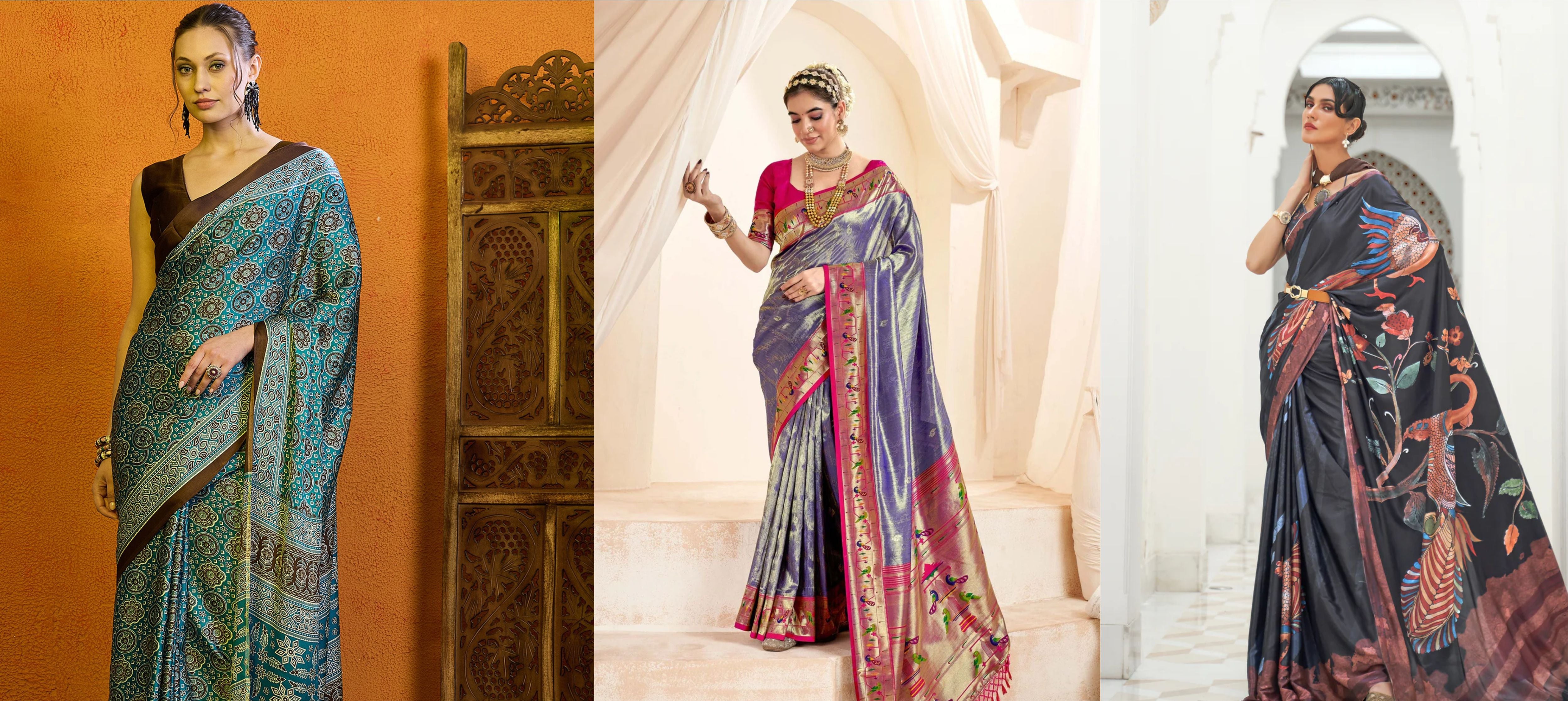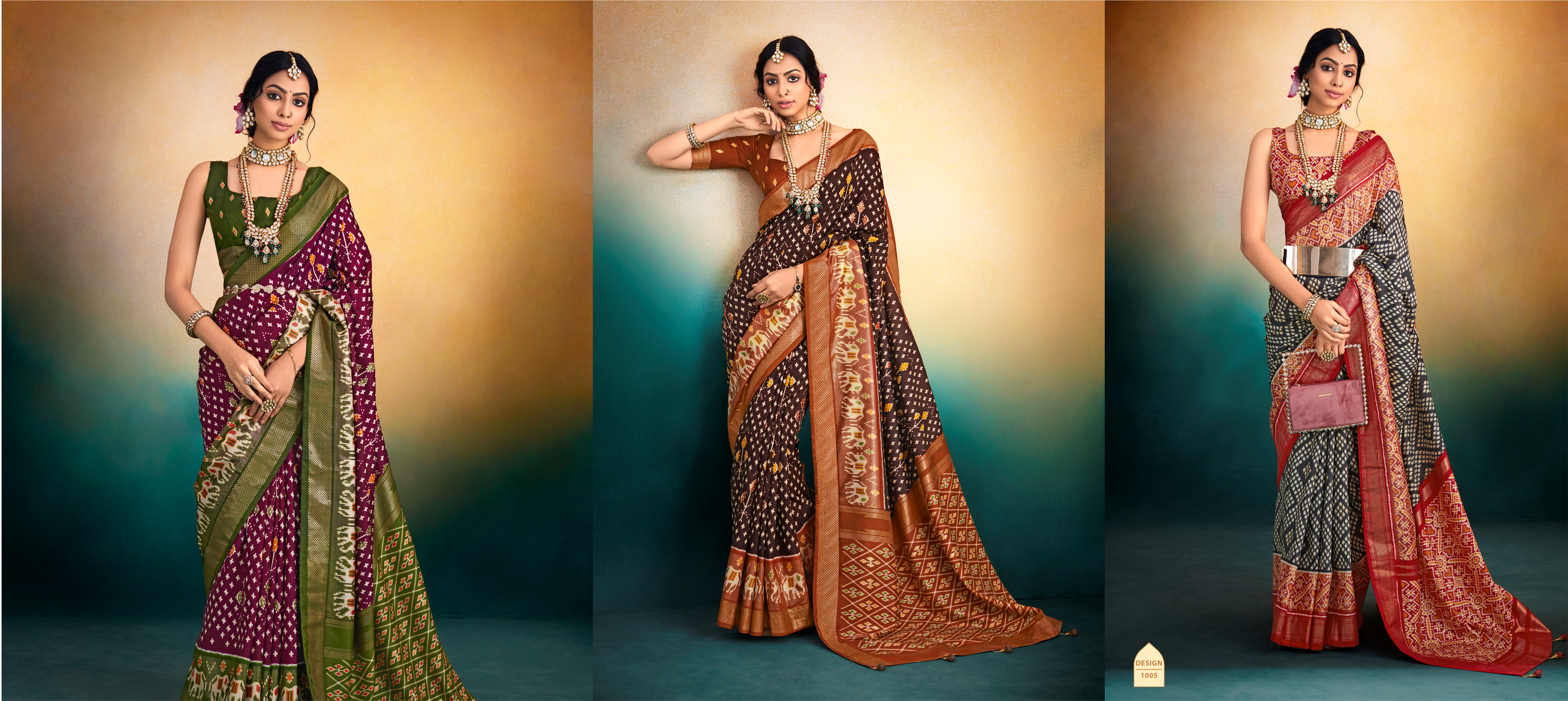
Exploring the Diverse Sarees of India: A Journey Through Tradition and Craftsmanship

India, a land known for its rich cultural heritage and diverse traditions, boasts an incredible array of sarees, each unique to its region. The saree, an epitome of grace and elegance, is not just an attire but a celebration of the artistry and craftsmanship that has been passed down through generations. Let's embark on a journey through the vibrant map of India and explore the different types of sarees that each state is famous for.
Northern India
1. Pashmina (Jammu and Kashmir):
Renowned for its luxurious texture and warmth, Pashmina shawls and sarees from Jammu and Kashmir are made from the fine wool of the Pashmina goat. These exquisite pieces are a testament to the skilled artisans who meticulously handcraft each shawl and saree.

2. Phulkari (Punjab):
Phulkari, meaning "flower work," is a traditional embroidery style from Punjab. These sarees are adorned with colorful and intricate floral patterns, reflecting the vibrant culture and festivities of the region.

3. Panja Weave (Haryana):
Haryana's Panja weave sarees are known for their durability and intricate designs. The weaving technique involves using a special tool called 'Panja' to create beautiful geometric patterns.

4. Shisha (Gujarat and Rajasthan):
Shisha or mirror work sarees from Gujarat and Rajasthan are famous for their sparkling embellishments. Small mirrors are intricately sewn onto the fabric, creating a dazzling effect that is perfect for festive occasions.

5. Bandhani (Gujarat and Rajasthan):
Bandhani sarees, also known as Bandhej, are a form of tie-dye textile art popular in Gujarat and Rajasthan. The sarees are characterized by their vibrant colors and intricate patterns created by tying small portions of the fabric before dyeing.

Central India
6. Paithani (Maharashtra):
Originating from Maharashtra, Paithani sarees are known for their opulent silk fabric and intricate zari work. These sarees often feature peacock motifs and are a symbol of elegance and tradition.

7. Chanderi (Madhya Pradesh):
Chanderi sarees from Madhya Pradesh are known for their sheer texture and lightweight fabric. They are often adorned with traditional motifs such as peacocks, florals, and geometric patterns, making them a popular choice for festive occasions.

8. Kosa Silk (Chhattisgarh):
Kosa silk, produced in Chhattisgarh, is a type of Tussar silk known for its natural texture and rich feel. These sarees are often dyed in vibrant colors and feature unique tribal designs.

Eastern India
9. Bhagalpuri Silk (Bihar):
Also known as Tussar silk, Bhagalpuri silk sarees from Bihar are celebrated for their natural gold sheen and rich texture. These sarees are perfect for both formal and casual occasions.

10. Chikankari (Uttar Pradesh):
Chikankari sarees from Lucknow, Uttar Pradesh, are renowned for their delicate and intricate hand embroidery. The elegant white-on-white embroidery is perfect for summer wear and formal occasions.

11. Jamdani (West Bengal):
Jamdani sarees from West Bengal are known for their exquisite craftsmanship and intricate patterns. These sarees are often woven with a mix of cotton and gold thread, creating a delicate and luxurious fabric.

12. Baluchari (West Bengal):
Baluchari sarees, also from West Bengal, are famous for their elaborate pallu designs that depict mythological scenes and stories. These sarees are a true representation of the region's artistic heritage.

13. Sambalpuri Saree (Odisha):
Sambalpuri sarees from Odisha are known for their unique ikat weaving technique. These sarees feature beautiful geometric patterns and vibrant colors, making them a popular choice for festive occasions.

14. Eri Silk (Assam):
Eri silk, also known as Ahimsa silk, is produced in Assam. These sarees are known for their durability and unique texture. Eri silk is often used to create traditional Assamese garments.

Southern India
15. Kanchipuram Silk (Tamil Nadu):
Kanchipuram silk sarees from Tamil Nadu are renowned for their rich texture, vibrant colors, and intricate zari work. These sarees are often worn at weddings and other grand celebrations.

16. Mysore Silk (Karnataka):
Mysore silk sarees from Karnataka are known for their smooth texture and lustrous finish. These sarees often feature traditional motifs and are a symbol of elegance and tradition.

17. Kasavu (Kerala):
Kasavu sarees from Kerala are characterized by their simple yet elegant design. These white sarees with golden borders are traditionally worn during festivals and special occasions in Kerala.

18. Pochampally Ikat (Telangana):
Pochampally Ikat sarees from Telangana are famous for their geometric patterns and vibrant colors. The unique ikat dyeing technique involves resist-dyeing the threads before weaving, resulting in beautiful and intricate designs.

19. Kalamkari (Andhra Pradesh):
Kalamkari sarees from Andhra Pradesh are known for their hand-painted designs. These sarees often depict mythological scenes, floral motifs, and intricate patterns, making them a true work of art.

Northeastern India
20. Muga Silk (Assam):
Muga silk sarees from Assam are known for their natural golden sheen and durability. These sarees are often adorned with traditional Assamese motifs and are a symbol of luxury and elegance.

21. Naga Shawl (Nagaland):
Naga shawls from Nagaland are known for their bold and vibrant designs. These shawls often feature geometric patterns and are a symbol of the rich cultural heritage of the Naga tribes.

22. Apatani (Arunachal Pradesh):
Apatani weaves from Arunachal Pradesh are known for their intricate designs and traditional patterns. These handwoven textiles are a representation of the region's rich cultural heritage.

23. Lepcha (Sikkim):
Lepcha weaves from Sikkim are known for their vibrant colors and intricate designs. These traditional textiles are a reflection of the rich cultural heritage of the Lepcha community.

24. Phanek (Manipur):
Phanek sarees from Manipur are known for their unique weaving techniques and traditional patterns. These sarees often feature bold colors and are a symbol of the rich cultural heritage of Manipur.

25. Puan (Mizoram):
Puan sarees from Mizoram are known for their intricate designs and traditional motifs. These handwoven textiles are a reflection of the rich cultural heritage of the Mizo community.

In conclusion, each saree from different states of India tells a unique story of tradition, craftsmanship, and cultural heritage. At Namaskar Styles, we take pride in bringing you a diverse collection of these exquisite sarees, allowing you to experience the beauty and elegance of Indian craftsmanship. Explore our collection and find the perfect saree to add to your wardrobe.



